How to Freeze Peppers
Whether you have a garden or not, filling your freezer with fresh summer produce is a great way to stock a self-reliant kitchen. These tips will help you with the best way on how to freeze peppers so they are fresh and ready to use in your favorite recipes.
Living a simple life is easier when you have a freezer full of food that you grew or was grown organically.
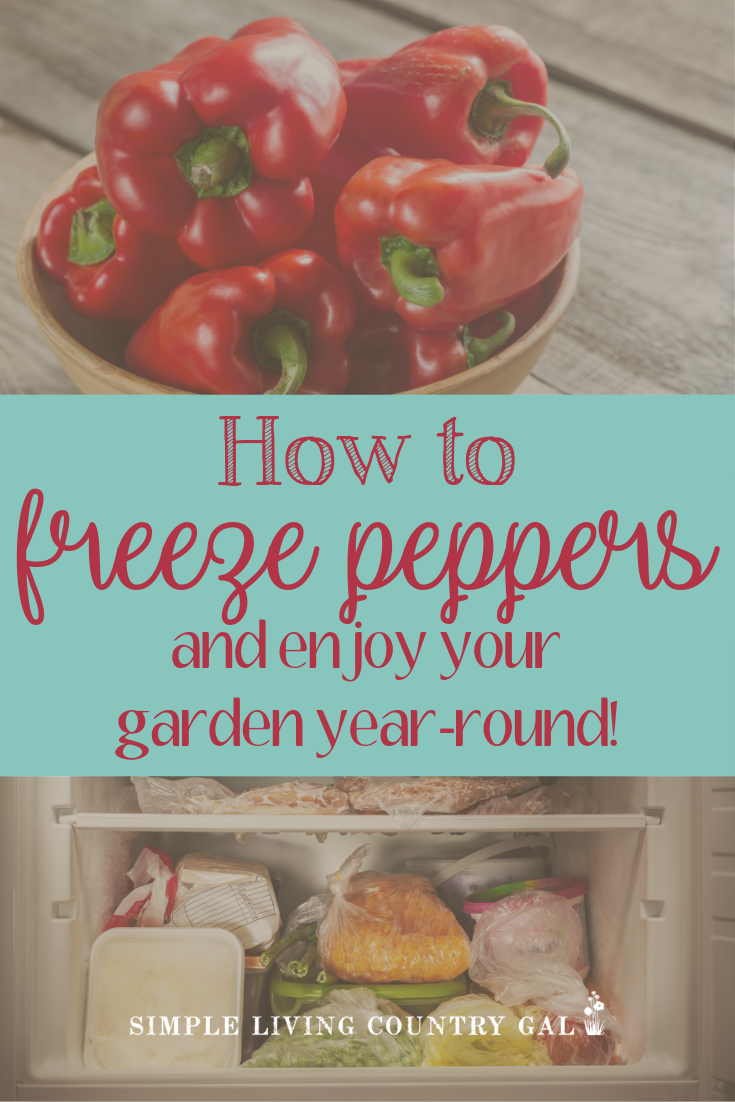
One of my favorite things to grow in my garden is peppers. And this Gardening 101 tip is one you are going to love!
There are so many varieties out there, you can literally fill a 20′ x 40′ garden with hundreds of plants all producing a different variety. On the other hand, freezing peppers can be a bit tricky. Over the years I learned a few tips on how to freeze peppers so they are just as good coming out as they were going in.
Even if you are not a fan of spicy food, peppers are something you should consider growing. I cannot tell you how many times I have tried a new recipe that calls for diced peppers. They can add a kick or a touch of sweetness, giving a great flavor to many dishes. From eggs to stews, there is so much you can add peppers to.
Having a self-reliant kitchen means that most, if not all, of the ingredients you need are in stock at all times. This includes your pantry and your freezer. The more produce you have in your freezer, the less you spend on lower-quality grocery produce in the off-season.
It is important to note that frozen peppers are not good to thaw and eat raw. Since peppers contain a large amount of water, freezing and thawing them gives a mushy consistency. However, frozen peppers are great for almost any recipe, including omelets.
The trick when freezing produce is to figure out how to do it correctly. Peppers need to be seeded and diced before freezing. Also, peppers contain a lot of water, meaning if not frozen correctly, you will end up with a bag of ice rather than diced peppers.

How to Freeze Peppers
Since peppers contain so much water, our goal is to freeze individual cuts that stay separated while frozen. These steps will help you to do that without having a frozen chunk of peppers in your freezer.
Step #1. Only Freeze the Freshest
Since peppers can turn soft rather quickly, picking them the day you plan to freeze them is important. One of the best parts of freezing your own produce is that you know for certain when everything is picked, which is why freezing produce from a grocery store is not recommended.
To keep all those wonderful vitamins and nutrients intact, you will want to freeze as soon as possible, preferably immediately after picking.
When is the best time to pick peppers?
You will want to harvest your peppers when they feel firm and are ripe. Peppers will change colors on the plant usually starting out as green then turning to red, yellow, even purple.
The longer you leave peppers on the plant, the hotter the flavor.
Food Dicer Chopper 5 Blades, Onion Dicer Chopper, Kitchen Chopper, Fruit and Veggie Chopper for Vegetables Chopper, Food Prep Chopper, Light Green




Step #2. Make sure to choose the best peppers
To ensure your peppers freeze well and stay fresh, only freeze your best produce. If you find a pepper with a blemish, I would not freeze it.
Instead, cut out the offending section of the pepper and dice or cut it into strips. Put it into a container and store it in your refrigerator to use in your next meal. Cut peppers will last a few days in the refrigerator.
I like to do a sort of my harvest before I start prepping for freezing. This will help me to see how much I have to process and how much I will need to use up quickly.
Step #3. Wash, rinse, repeat
Gently wash your peppers being careful not to scrub them. You want your produce to be in the best shape possible, so wash gently so you do not bruise.
Let peppers sit to air dry on a towel right as you continue washing the next batch.
Use a paper towel to remove any excess water before you begin dicing.
Step #4. Wear Protection
Even if you are only working with mild-flavored peppers such as the Bell variety, you must wear gloves when working with them.
I cannot tell you how many times I have frozen peppers without gloves, thinking I would be just fine. However, even after washing them several times throughout the day, by evening my hands would burn.
My advice is to wear gloves, even if you are barely touching the peppers. Juices from even mild peppers can irritate your skin, and you may not realize it until later on.
Also, be sure not to touch or rub your eyes. I have done this (several times, actually), and the burn was instant and painful.
I like thin gloves like these. They work great and are pretty inexpensive. Or you can use kitchen gloves like these if you prefer.
(Warning…some gloves have latex, like the kitchen gloves I link to here. Please make sure you are not allergic to latex before using.)
Step #5. Seed your peppers and core.
Cut your peppers to remove the seeds and inner membrane. I prefer to use my hands (don’t forget your gloves) for this step as I find it easier to pull the seeds and membrane out rather than slice it.
SLCG Pro Tip: If you want spicy or even hot peppers, you can opt to leave the seeds in along with the membrane. The more you leave, the hotter they will be.
Step #6. Dice in equal sizes
When dicing, be sure to cut pieces close to the same size. This will help with even cooking later on. You can use a knife and dice the traditional way or try this helpful shortcut.
Preserving foods can take quite a bit of time, and as a midlife homesteader, finding shortcuts helps me to be kinder to my back. For that reason, I purchased a manual food dicer that was pretty affordable.
This dicer has saved me so much time and ensured my dices are uniform in size.
I use the Vidalia Chop Wizard that I purchased many years ago. It still works great, is easy to clean, and can be used with just about any veggie.
Food Dicers I love:
Step b#7. Par freeze
This is the main tip for keeping ice off your peppers. Since peppers have so much water, you will want to keep them separated until frozen. This will help deter clumping in the freezer bags.
First, line a baking sheet with foil and arrange your peppers in a single layer. Freeze in the freezer for 15-20 minutes uncovered.
This is called par freezing, and it will prevent your peppers from clumping in the bags. It will also prevent chunks of ice from forming.
Step #8. Put peppers into labeled freezer bags
After a few minutes, check the peppers to see if they feel frozen. If yes, quickly put the peppers into freezer bags so you can get them back into the freezer quickly.
Any defrosting will add moisture to the peppers causing ice to form which is what we do not want.
I like to use one-quart bags as this sized bag is easier for our family and keeps the peppers fresh longer. The more you open a bag to remove what’s inside, the more air you let in, causing ice crystals to form on your delicate produce.
Small bags keep opening and closing to a minimum resulting in better peppers.
Step #9. Remove as much air as you can
This is another step that is important not to skip when freezing peppers. Having air in those bags can cause ice to form. Ice on peppers is bad, so we want to do as much as we can to prevent it.
Squeezing the air out before sealing the bag will work great, but take it one step further. Use a straw to suck the extra air out and get the best air-tight freeze.
Or you can purchase a vacuum sealer and freeze your produce with little air.
Step #10. Freeze
If you haven’t done so yet, label and date the bags before you freeze them. This will ensure you use up produce in a timely matter. Lay the bags flat on your freezer shelf or freeze them vertically in a freezer drawer—whatever works best for your freezer’s style.
You can keep your frozen bags in plastic baskets in your freezer for easy organization. These baskets are my go-to tool for organizing my chest freezers.
Yes, they are recycling baskets and are NOT cheap, but again they are worth the money for me, and I just love them.
If your freezer is a mess, you can get tips on how to clean a freezer here.
If you already have produce in your freezer from last season, you will want to put your fresh produce behind to ensure you use up the older produce first.
Peppers frozen using the steps outlined in this article will hold up well for up to a year.
You can freeze pepper varieties separately or together for a seasonal mix.
What are the heat levels of peppers?
- Sweet pepper/mild heat – Bell Peppers
- Medium heat – Banana Peppers and Hungarian Wax Peppers
- High heat – Jalapeños, Chili, and Habanero peppers.
There is nothing I love more than having fresh organic ingredients in my freezer and pantry to enjoy year-round. With just a little planning and prep work, you can fill your freezers with hot and spicy summer goodies.
And no, you do not need a garden to do this. A few planters on your patio or porch can also grow enough to freeze peppers for your family.
Freezing Perfect Peppers
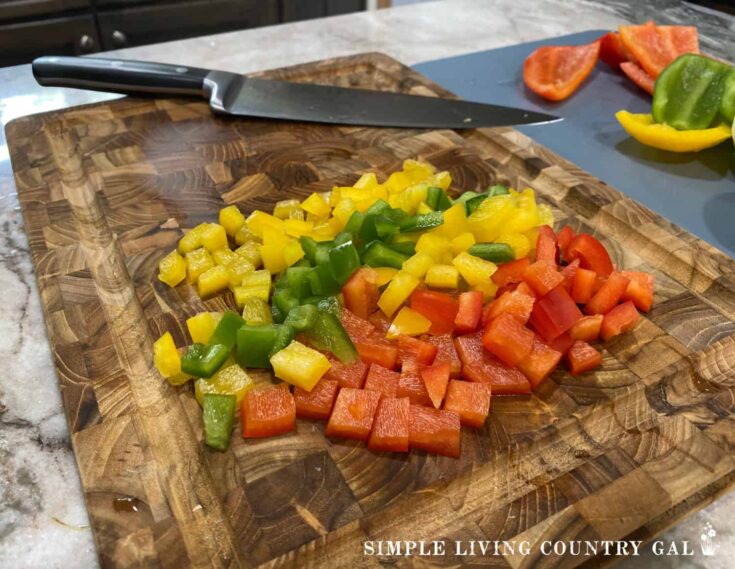
Fill your freezer with fresh amazing produce that tastes just as good coming out as it did going in! These tips will help you to freeze bags of peppers that are free of ice crystals and do not clump.
Ingredients
- 16 Whole Bell Peppers (You can also use any type of pepper here. )
- 4 1 Quart Freezer Bags
- Cookie Sheet
- Foil to line the sheet during freezing
Instructions
- Sort your pepper harvest removing any peppers with blemishes.
- Wash peppers and allow them to dry on a towel.
- Use a paper towel to remove any excess water before dicing.
- Cut the pepper in half and remove the core, membrane, and any seeds. Be sure to wear gloves.
- Using a knife, cut into equal sizes. You can also use a dicer to speed this step up.
- Place diced pepper onto a foil lined cooking sheet and place in the freezer for 15-20 minutes.
- If frozen, quickly place them into 1-quart freezer bags.
- Remove all the air before sealing.
Notes
When using peppers from the freezer, remove the portion needed quickly. Air can quickly defrost the contents, causing ice to form later.
Peppers frozen correctly will last up to one year in the freezer.
Use peppers in any recipe!
How to Grow Resources for Your Garden:
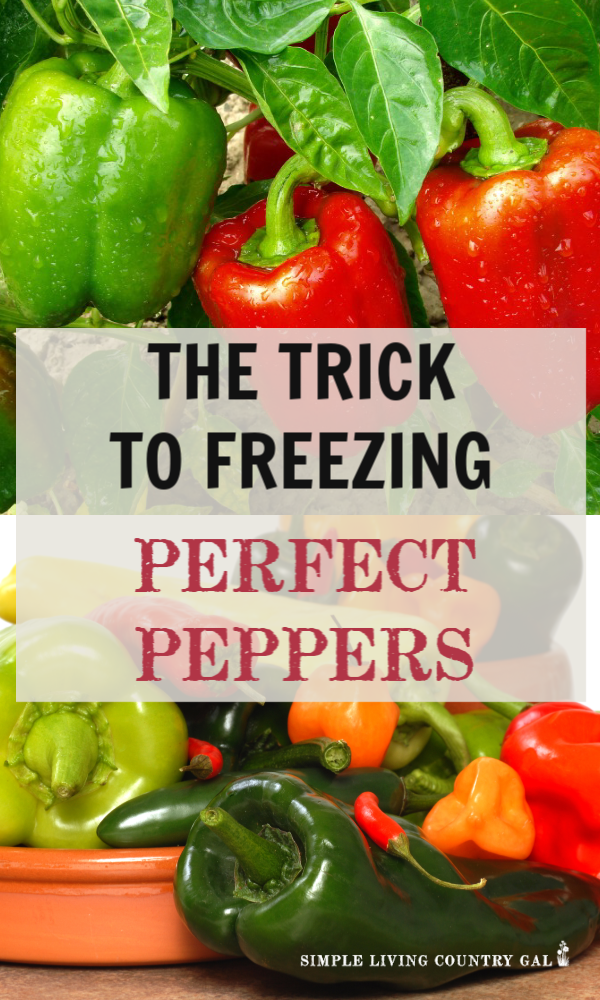

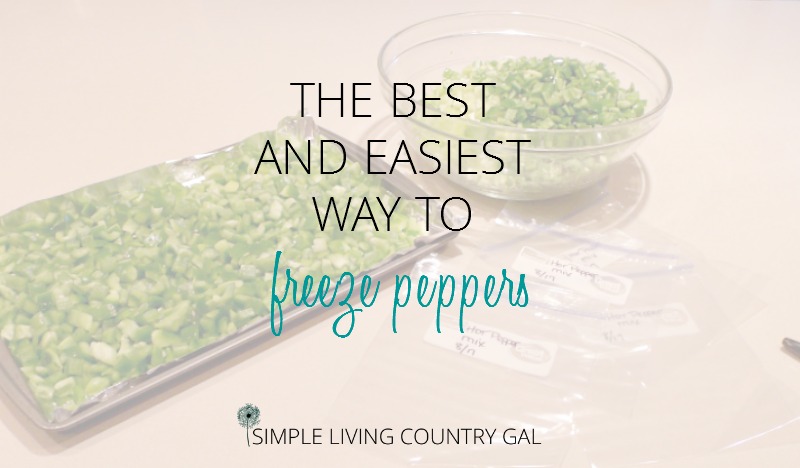
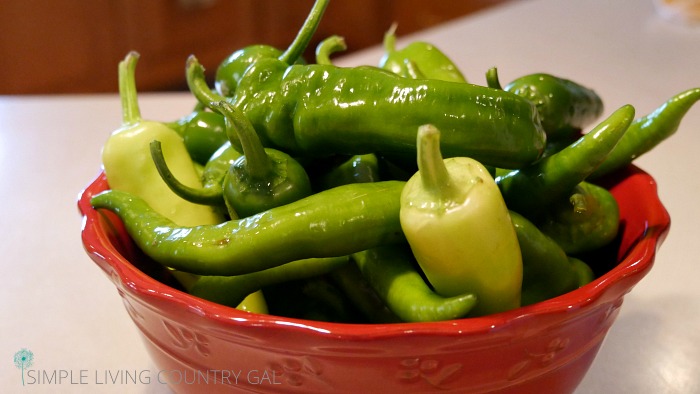







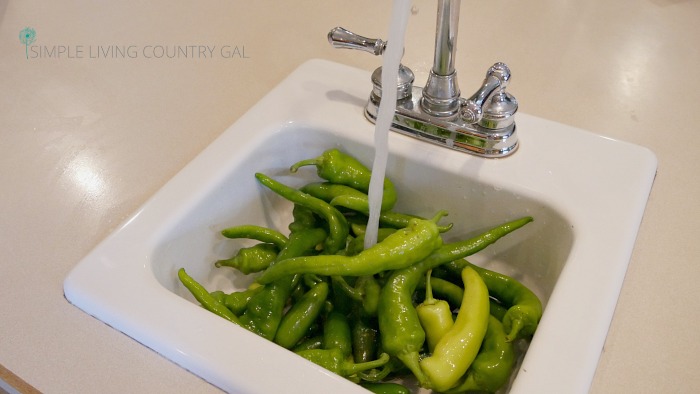
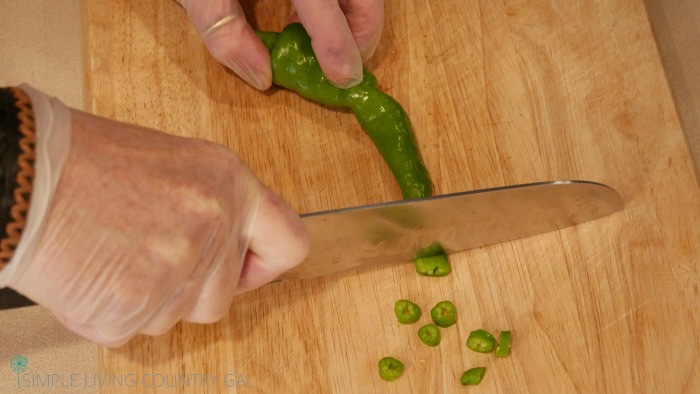

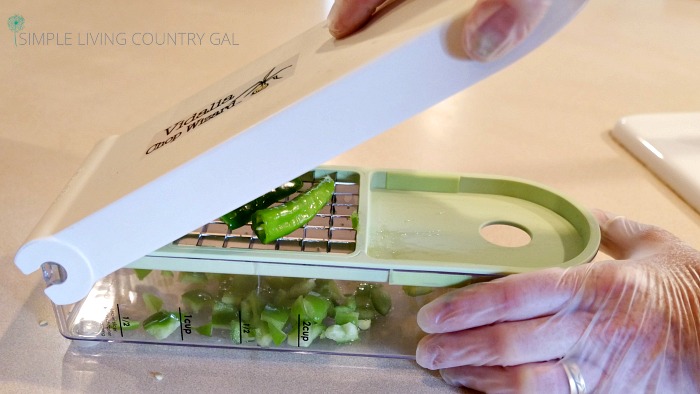

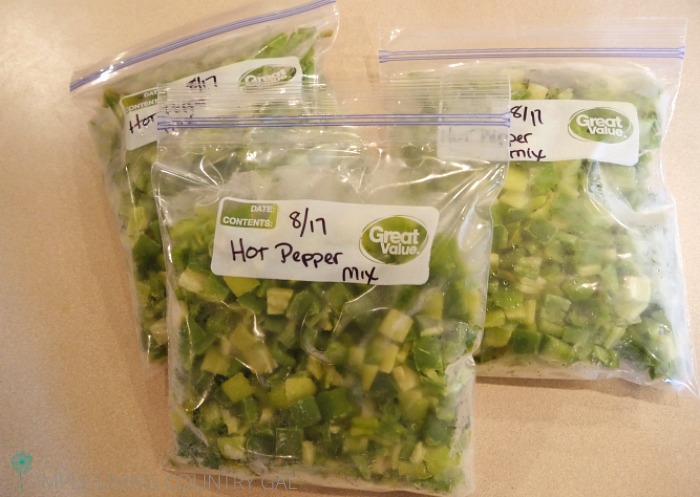

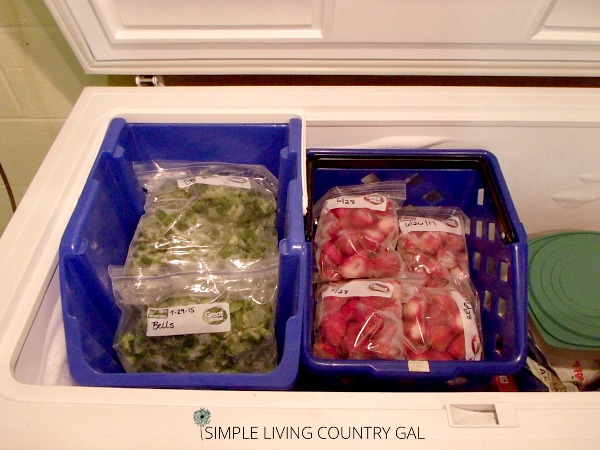
I have found that my bell peppers get extremely bitter if I freeze them – even when added in a recipe – unless I char the skins and remove them first. Have you ever had that problem, and do you have a solution for it?
Hi, Theresa,
If you have bitter tasting peppers, odds are they did not get enough water during growing season. This tends to happen in very dry climates or in areas with dry and hot summers. It should not have anything to do with freezing them, but it may make the bitter taste a bit more obvious.
Maybe next season increase your watering time to see if that helps?
Tracy Lynn
Great post! Thanks for sharing it with us at the Homestead Blog Hop!
Great article, thanks for sharing?
Do you find that the peppers lose some heat the longer they stay frozen? We plan our preserves toast about a year, and some veggies, though still good to use, tend to lose some their ‘oomf.’
Have a wonderful week!
If you do, then I would include the seeds and part of the membrane when freezing to pack in a little “extra” heat.